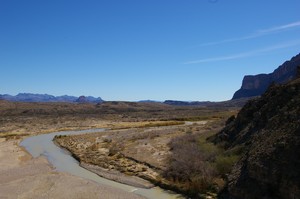 Our hopes for the opening of the border have come to naught. We have asked regularly and been given a number of answers ranging from speculation and rumour about possible dates to somewhat cynical comments about politicians and their inability to organise a soiree in a vineyard. We finally gave up hope a few days ago when we saw this notice at the Castolon Visitor Center. So, after four weeks in this wonderful park, we’re finally preparing to leave. Hopefully the border will be open when we return at some point in the future.
Our hopes for the opening of the border have come to naught. We have asked regularly and been given a number of answers ranging from speculation and rumour about possible dates to somewhat cynical comments about politicians and their inability to organise a soiree in a vineyard. We finally gave up hope a few days ago when we saw this notice at the Castolon Visitor Center. So, after four weeks in this wonderful park, we’re finally preparing to leave. Hopefully the border will be open when we return at some point in the future.
Spending so long in a comparatively isolated park required considerable planning to ensure that we had a reasonably healthy diet whilst we’ve been here. There are stores in the park but they are painfully restricted in what they carry. Before leaving civilisation we anticipated the staples that we’d need for the coming month, stocked up on long-lasting veg such as squash, mapped out many meals and even cooked and froze an array of dinners. Given that bags of salad are the only thing that passes for a green vegetable in the shops here, this was probably just as well. The fridge is looking extremely bare and I’m beginning to run out of ideas resorting on our last night to a tarka dall, our last grains of rice and a quorn and lima bean bhaji - the latter certainly not standard ingredients in any Indian restaurants that I know. To those who know me personally, the words “scrab ends” should convey the situation. It’s time to leave and replenish stocks.
 Not surprisingly, one staple that is mostly available in the park is beer and it was here that we discovered our national beer. Lone Star beer claims to be “The National Beer of Texas” and for those non-American readers here’s a potted history: Texas is the only state that at one time was an independent nation, albeit for a short ten years after it gained independence from Mexico in 1836. There are still some in Texas who want to secede from the United States and become an independent nation once again. It’s difficult to know whether the brewers are actually of this mind set or whether it’s just a nod in that direction. Our motivations for changing domicile are much more mundane than the desire to move country again. Texas chose not to locally administer the pre-existing conditions health insurance plan that is part of President Obama’s Affordable Care Act; presumably a decision intended to signal their disapproval of the new legislation. Consequently the plan in Texas, as well as in some other states, is being administered on a federal level and certainly in our experience seems more liberal in an attempt to be as inclusive as the legislation intended. That’s good news for a lot of people. Enough politics.
Not surprisingly, one staple that is mostly available in the park is beer and it was here that we discovered our national beer. Lone Star beer claims to be “The National Beer of Texas” and for those non-American readers here’s a potted history: Texas is the only state that at one time was an independent nation, albeit for a short ten years after it gained independence from Mexico in 1836. There are still some in Texas who want to secede from the United States and become an independent nation once again. It’s difficult to know whether the brewers are actually of this mind set or whether it’s just a nod in that direction. Our motivations for changing domicile are much more mundane than the desire to move country again. Texas chose not to locally administer the pre-existing conditions health insurance plan that is part of President Obama’s Affordable Care Act; presumably a decision intended to signal their disapproval of the new legislation. Consequently the plan in Texas, as well as in some other states, is being administered on a federal level and certainly in our experience seems more liberal in an attempt to be as inclusive as the legislation intended. That’s good news for a lot of people. Enough politics.
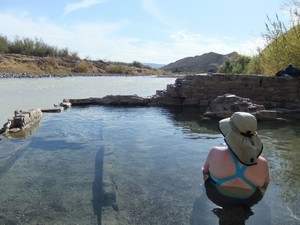 A series of hot springs line the banks of the Rio Grande, many quite small but one large enough to warrant capture in a bath house during the 1920s. The river took exception to the intrusion and swept the building away during a flood in 1932 but the foundation remains and acts as a temporary holding vessel for enough of the 105 degree water for modern day bathers to take a shallow dip. It’s a wonderful spot; Mexico is a matter of twenty feet across the river, the views pleasing and the water delightful.
A series of hot springs line the banks of the Rio Grande, many quite small but one large enough to warrant capture in a bath house during the 1920s. The river took exception to the intrusion and swept the building away during a flood in 1932 but the foundation remains and acts as a temporary holding vessel for enough of the 105 degree water for modern day bathers to take a shallow dip. It’s a wonderful spot; Mexico is a matter of twenty feet across the river, the views pleasing and the water delightful.
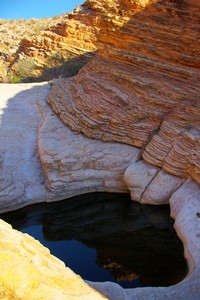 A couple of nights at Candelilla backcountry site on the Old Ore Road gives us the opportunity of hike out to Ernst Tinaja which is a year-round pool of water collected in a large depression in the limestone bedrock. Near the tinaja, the close quartered canyon walls are delineated by beautiful red, pink and yellow strata, the floor a small series of smooth sculptured holes stepping down to the widening dry water bed. It’s a truly magical place and well worth the nine mile round trip to see it.
A couple of nights at Candelilla backcountry site on the Old Ore Road gives us the opportunity of hike out to Ernst Tinaja which is a year-round pool of water collected in a large depression in the limestone bedrock. Near the tinaja, the close quartered canyon walls are delineated by beautiful red, pink and yellow strata, the floor a small series of smooth sculptured holes stepping down to the widening dry water bed. It’s a truly magical place and well worth the nine mile round trip to see it.
We head for the south west corner of the park on the Ross Maxwell Scenic Drive stopping to do some of the many short hikes leaving from the road. A couple stand out; the first goes out to the Lower Burro Pour-off. The trail follows a wash narrowing into a box canyon that ends with a vertical wall sculpted by unmeasured gallons of water that have scoured the impressively large chute. The sun is still low in the sky at this time of year and the canyon floor is refreshingly cool as we sit listening to the bees, busy on the tiny flowers of an adjacent bush.
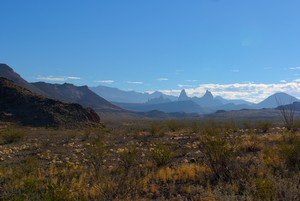 The second is a desert trail going out to Mule Ears Spring with fantastic views of the appropriately named twin peaks. The terrain is varied, the views including the asinine pinnacles as well as Santa Elena Canyon off in the distance; our destination the only place we have heard running water other than the actual year-round rivers. The spring gurgles out amid a display of bright green plants rarely seen in this parched land, the Cottonwoods offering some shade for a welcome break before our return to the trailhead.
The second is a desert trail going out to Mule Ears Spring with fantastic views of the appropriately named twin peaks. The terrain is varied, the views including the asinine pinnacles as well as Santa Elena Canyon off in the distance; our destination the only place we have heard running water other than the actual year-round rivers. The spring gurgles out amid a display of bright green plants rarely seen in this parched land, the Cottonwoods offering some shade for a welcome break before our return to the trailhead.
A couple of nights in Cottonwood campsite give us a glimpse into the work of Border Patrol. They pull up outside one of the pit loo blocks and of course our first thought is that they need to use the necessarium. They each approach one of the buildings but instead of availing themselves of the facilities, simply open the doors and check inside before moving onto the next block and checking it. Presumably, they have previously found people hiding there.
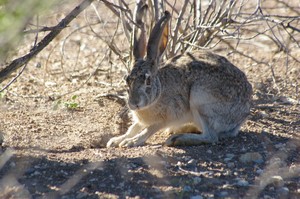 Our last stop in the park is a three night stay at Ocotillo Grove, another backcountry site off the Old Maverick Road. It gives us another chance to catch up with a bit of work while taking short afternoon hikes. One of these is down to Terlingua Creek which we cross in search of what proves to be the elusive ruin of Terlingua Abajo. On our last day at Ocotillo, the wind gets up and a dust cloud slowly but surely thickens as the morning goes on. We batten the hatches, prepare to put the satellite dish down and abandon our plans for an afternoon hike. In spite of this, it’s been a good place for our last nights. We’ve seen kangaroo rats and jack rabbits and a virtually full moon rise majestically over the horizon to bathe the camper in moonlight.
Our last stop in the park is a three night stay at Ocotillo Grove, another backcountry site off the Old Maverick Road. It gives us another chance to catch up with a bit of work while taking short afternoon hikes. One of these is down to Terlingua Creek which we cross in search of what proves to be the elusive ruin of Terlingua Abajo. On our last day at Ocotillo, the wind gets up and a dust cloud slowly but surely thickens as the morning goes on. We batten the hatches, prepare to put the satellite dish down and abandon our plans for an afternoon hike. In spite of this, it’s been a good place for our last nights. We’ve seen kangaroo rats and jack rabbits and a virtually full moon rise majestically over the horizon to bathe the camper in moonlight.
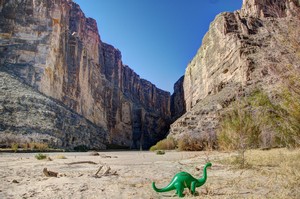 We have one final short hike planned on our way out of the park; Santa Elena Canyon. There are no other humans around as we arrive at the trailhead and walk across the sand. Large paw prints indicate that someone else has been here since the wind dropped overnight. Unfortunately, or not, we don’t see the kitty in question and carry on along the cemented trail switchbacking up the canyon side before descending to a more natural path at water level. The water is slow and sluggish, the canyon cool and quiet. The sheer walls rise hundreds of feet above us, huge blocks of rock litter the floor and the sun barely reaches past the mouth of the canyon. It’s yet another face of this multi-faceted park and we’re pleased to end with this walk.
We have one final short hike planned on our way out of the park; Santa Elena Canyon. There are no other humans around as we arrive at the trailhead and walk across the sand. Large paw prints indicate that someone else has been here since the wind dropped overnight. Unfortunately, or not, we don’t see the kitty in question and carry on along the cemented trail switchbacking up the canyon side before descending to a more natural path at water level. The water is slow and sluggish, the canyon cool and quiet. The sheer walls rise hundreds of feet above us, huge blocks of rock litter the floor and the sun barely reaches past the mouth of the canyon. It’s yet another face of this multi-faceted park and we’re pleased to end with this walk.
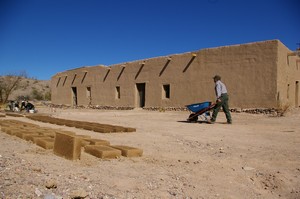 A hive of activity around the ruin of the Alvino House at Castolon piqued our curiosity as we drove past on our way out of the park and we stopped to investigate. The ground was covered in neat rows of adobe bricks at various stages of being made and drying. A crew were busy at work mixing mud brought from near the river with horse manure in a cement mixer, the result being packed into adobe brick molds which are then removed leaving the wet bricks to bake in the sun. A flood had damaged the lower levels of the ruin and in an attempt to prevent further deterioration, they are being replaced using these bricks made in the traditional manner.
A hive of activity around the ruin of the Alvino House at Castolon piqued our curiosity as we drove past on our way out of the park and we stopped to investigate. The ground was covered in neat rows of adobe bricks at various stages of being made and drying. A crew were busy at work mixing mud brought from near the river with horse manure in a cement mixer, the result being packed into adobe brick molds which are then removed leaving the wet bricks to bake in the sun. A flood had damaged the lower levels of the ruin and in an attempt to prevent further deterioration, they are being replaced using these bricks made in the traditional manner.
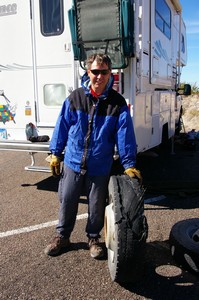 As it turned out, our final photograph in Big Bend was not of adobe bricks being made. A few miles down the road, an almighty bang explodes behind us and in one of those inexplicable flashes of thought I think that the camper has fallen off the truck. Fortunately it’s nowhere near that drastic – we’ve blown one of the inner dual tires in a quite dramatic fashion. After some faff, we drive very slowly to a trailhead where Sterling proceeds to change the wheel. I’ll leave the full story to one of his Notes articles. Suffice to stay we managed to limp into Terlingua and are now awaiting the arrival of a new set of tires.
As it turned out, our final photograph in Big Bend was not of adobe bricks being made. A few miles down the road, an almighty bang explodes behind us and in one of those inexplicable flashes of thought I think that the camper has fallen off the truck. Fortunately it’s nowhere near that drastic – we’ve blown one of the inner dual tires in a quite dramatic fashion. After some faff, we drive very slowly to a trailhead where Sterling proceeds to change the wheel. I’ll leave the full story to one of his Notes articles. Suffice to stay we managed to limp into Terlingua and are now awaiting the arrival of a new set of tires.
30th April 2013: Mark Castleman, a friend of ours, has kindly pointed out a correction. He tells me that "Texas is one of three states which were independent in a meaningful way. The other two are Hawaii and Vermont, though California makes a rather shaky claim to it also."